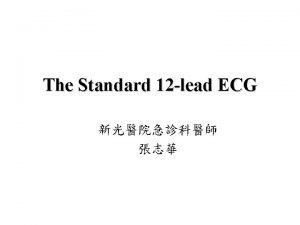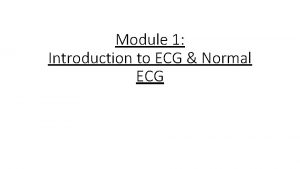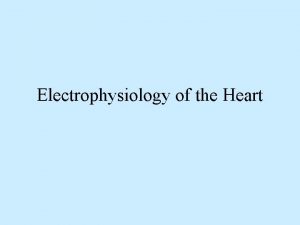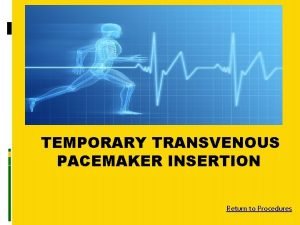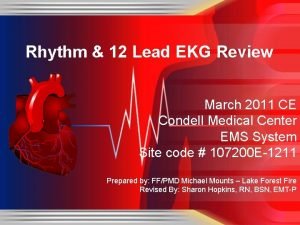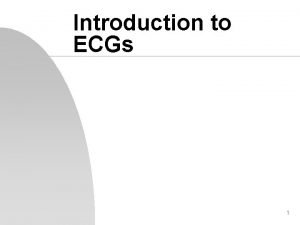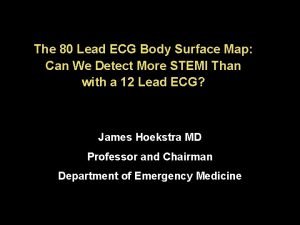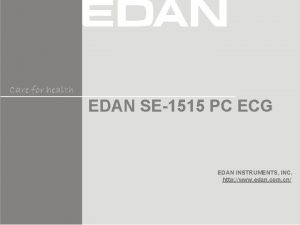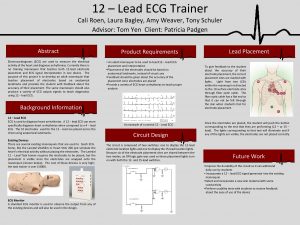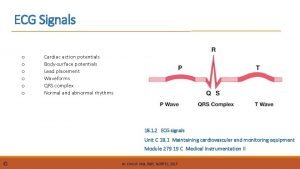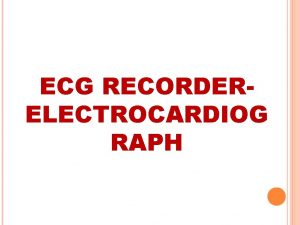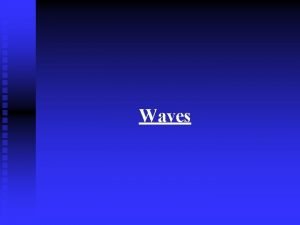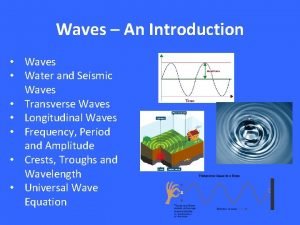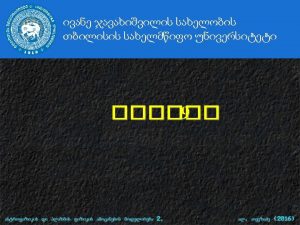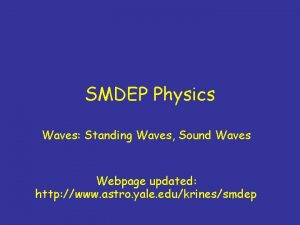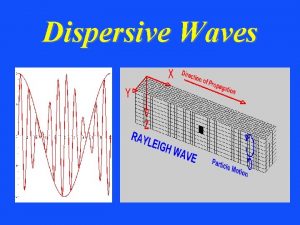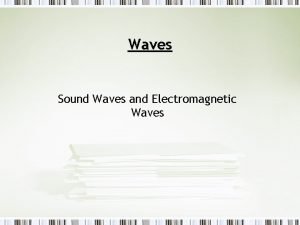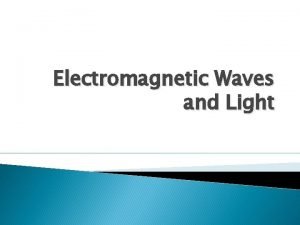The Standard 12 lead ECG ECG Waves Orientation



























- Slides: 27

The Standard 12 -lead ECG 新光醫院急診科醫師 張志華

ECG Waves

Orientation

Standard Limb Leads

Einthoven's Triangle

Limb Leads * * *

Precordial Leads

Rate • 300 / 中格數 Irregular rate • No of R in 6 -s strip x 10

Rate and Rhythm ?

Axis: Normal I a. VF

Left Axis Deviation (LAD) a. VR I a. VF

Right Axis Deviation (RAD) a. VR I a. VF

Axis ?

Einthoven's Triangle

Measurements • Heart Rate: – 60 - 100 bpm • PR Interval: – 0. 12 - 0. 20 sec • QRS Duration: – 0. 06 - 0. 10 sec • QT Interval (QTc < 0. 40 sec; abnormal if > 0. 425 sec) – Bazett's Formula: • QTc = QT/ RR (in seconds) – Poor Man's Guide to upper limits of QT: • • • For HR = 70 bpm, QT < 0. 40 sec HR ↑ 10 bpm above 70 - 0. 02 sec HR ↓ 10 bpm below 70 + 0. 02 sec If HR = 80 bpm QT < 0. 38 sec If HR = 60 bpm QT < 0. 42 sec

Test

Precordial Leads

Precordial Leads • Small r-waves begin in V 1 or V 2 and progress in size to V 5 • The R-V 6 is usually smaller than R-V 5 • In reverse, the s-waves begin in V 6 or V 5 and progress in size to V 2 • S-V 1 is usually smaller than S-V 2 • The usual transition from S>R in the right precordial leads to R>S in the left precordial leads is V 3 or V 4 • Small "septal" q-waves may be seen in leads V 5 and V 6

Precordial (chest) electrodes V 5 & V 6 located over left ventricle V 1 & V 2 located over right ventricle V 3 & V 4 located over interventricular septum

Counter-clockwise Rotation

Clockwise Rotation

Measurements • Heart Rate: – 60 - 100 bpm • PR Interval: – 0. 12 - 0. 20 sec • QRS Duration: – 0. 06 - 0. 10 sec • QT Interval (QTc < 0. 40 sec) – Bazett's Formula: • QTc = QT/ RR (in seconds) – Poor Man's Guide to upper limits of QT: • • • For HR = 70 bpm, QT < 0. 40 sec HR ↑ 10 bpm above 70 - 0. 02 sec HR ↓ 10 bpm below 70 + 0. 02 sec If HR = 80 bpm QT < 0. 38 sec If HR = 60 bpm QT < 0. 42 sec

ECG Waves

Intervals QRS (3) (3 -5) RR PR (1) QT (2)

Test

QT Interval • Ccorrected QT – QTc = measured QT / sq-root RR in seconds – Upper limit for QTc = 0. 44 sec • Long QT Syndrome - "LQTS" – QTc > 0. 47 sec for males – > 0. 48 sec in females – Increased vulnerability to malignant ventricular arrhythmias, syncope, and sudden death – Prototype: Torsade-de-pointes, a polymorphic ventricular tachycardia characterized by varying QRS morphology and amplitude around the isoelectric baseline.

LQTS Causes : – Drugs • Many antiarrhythmics • Tricyclics • Phenothiazines – Electrolyte abnormalities ( ↓K+, ↓ Ca++, ↓ Mg++) – CNS disease (SAH, stroke, trauma) – Hereditary LQTS (e. g. , Romano-Ward Syndrome) – Coronary Heart Disease (some post-MI patients)
 Ecg lead orientation
Ecg lead orientation Atrial fibrillation ecg
Atrial fibrillation ecg Qrs amplitude
Qrs amplitude Elevated t wave
Elevated t wave Do electromagnetic waves require a medium
Do electromagnetic waves require a medium Light is electromagnetic wave true or false
Light is electromagnetic wave true or false What are the mechanical waves
What are the mechanical waves What is a rainbow
What is a rainbow The wave chapter 13
The wave chapter 13 Sound waves longitudinal waves
Sound waves longitudinal waves Long waves and short waves
Long waves and short waves Mechanical waves and electromagnetic waves similarities
Mechanical waves and electromagnetic waves similarities Mechanical waves vs electromagnetic waves
Mechanical waves vs electromagnetic waves Similarities of mechanical and electromagnetic waves
Similarities of mechanical and electromagnetic waves Seismic waves
Seismic waves Is a seismic wave mechanical or electromagnetic
Is a seismic wave mechanical or electromagnetic Compare and contrast p waves and s waves using venn diagram
Compare and contrast p waves and s waves using venn diagram What do all waves transmit
What do all waves transmit The difference between constructive and destructive waves
The difference between constructive and destructive waves Transvenous pacing
Transvenous pacing Ecg lead placement
Ecg lead placement Ecg lead placement
Ecg lead placement Inferior septal wall
Inferior septal wall Ecg lead placement color coding
Ecg lead placement color coding Ecg lead map
Ecg lead map Edan se-1515 software download
Edan se-1515 software download Dr laura bagley
Dr laura bagley 5 lead ecg placement
5 lead ecg placement
